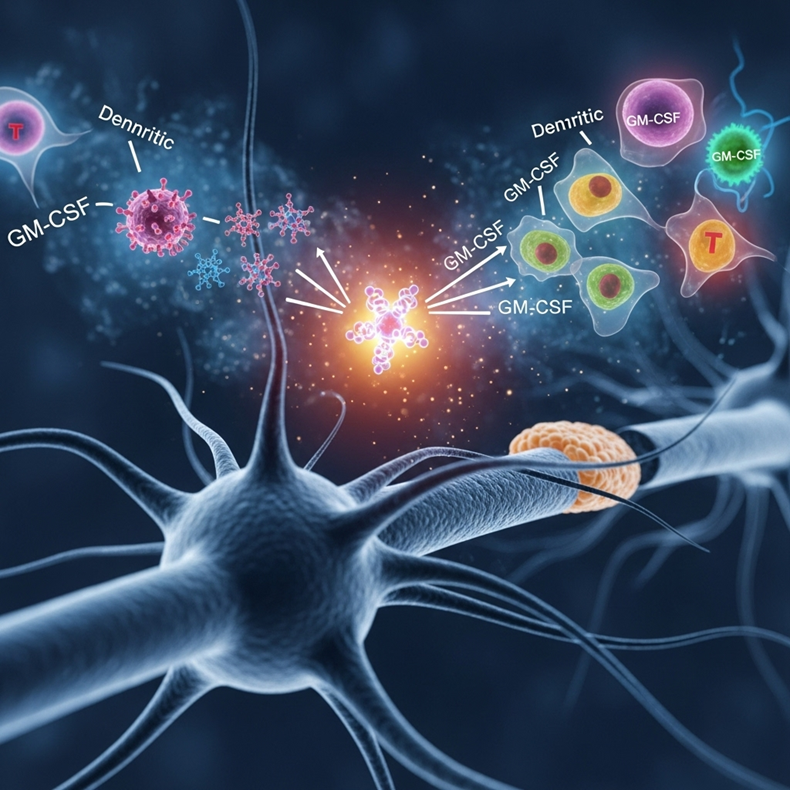
In the relentless pursuit of breakthrough therapies, the scientific community sometimes finds its most potent new weapons in familiar arsenals. Such is the story of Granulocyte-Macrophage Colony-Stimulating Factor (GM-CSF), a protein that, after decades of being known primarily as a supportive player, is now stepping into the spotlight as a strategic linchpin in some of today's most ambitious medical research, from cancer immunotherapy to the fight against neurodegeneration.
For years, GM-CSF was the reliable workhorse of hematology. As a cytokine—a signaling protein for the immune system—its primary job was understood to be stimulating the bone marrow to produce more white blood cells. This made therapeutic versions like Sargramostim and Molgramostim invaluable for cancer patients, helping them rebuild their immune systems after being ravaged by chemotherapy. But a wave of research cresting in 2024 and 2025 reveals this was only the opening act. Scientists now understand that GM-CSF doesn't just build an army; it acts as its field marshal, directing the most strategic units with profound precision.
From Support Player to Immune Architect
The key to GM-CSF's newfound stardom lies in its influence over dendritic cells. These cells are the intelligence officers of the immune system, capturing information from invaders like cancer cells or pathogens and presenting it to T-cells to initiate a targeted, adaptive attack. It turns out that GM-CSF is a master activator and maturer of these dendritic cells.
This function is proving to be a game-changer in oncology. In the context of CAR-T therapy and cancer vaccines, GM-CSF is being explored as an adjuvant to create a more "immunologically hot" tumor microenvironment. It essentially primes the battlefield, making cancer cells more visible and vulnerable to both engineered T-cells and the body's natural defenses. This shift from a recovery aid to a frontline offensive weapon represents a fundamental evolution in its therapeutic application.
An Unexpected Ally in Neurological Defense?
Perhaps the most surprising new chapter in the GM-CSF story is its emerging role in neurology. Pioneering studies are investigating its potential to combat neurodegenerative diseases like Alzheimer's. The hypothesis is that GM-CSF can stimulate microglia—the resident immune cells of the brain—to more effectively clear the amyloid-beta plaques associated with the disease's progression. While still in early stages, the prospect of repurposing an immune-stimulating factor to protect the brain has ignited tremendous excitement and opened up an entirely new avenue of clinical investigation.
This expanding utility extends to tissue repair, where GM-CSF's ability to recruit macrophages is being tested to accelerate the healing of chronic wounds, such as diabetic ulcers, which have long frustrated clinicians.
The Bedrock of Breakthroughs: The Need for Pure Reagents
This explosion of innovative research is not happening in a vacuum. The journey from a brilliant hypothesis to a validated result depends entirely on the quality and reliability of the tools used in the laboratory. For a molecule like GM-CSF, where subtle differences in concentration or purity can dramatically alter cellular responses, consistency is paramount.
Nadav Amarant of ProSpec-Tany TechnoGene Ltd., a company that specializes in producing recombinant proteins for research, offers an expert's perspective on this crucial foundation. "We are witnessing a paradigm shift in how scientists are utilizing GM-CSF," Amarant states. "As its applications become more sophisticated, the demand for impeccable purity and validated biological activity has never been higher. Researchers in these advanced fields cannot afford the ambiguity that comes from inconsistent reagents. Our mission is to provide that bedrock of certainty, ensuring that the GM-CSF they use today will behave exactly the same as the batch they use next year. We see ourselves not just as suppliers, but as partners in discovery."
This dedication to quality is what allows groundbreaking work to proceed. For scientists exploring these novel pathways, access to highly pure, stable, and biologically active proteins like GM-CSF Human is non-negotiable. It is the invisible scaffold upon which future clinical successes are built.
Bridging the Gap to Animal Health
The benefits of GM-CSF are not limited to humans. The protein exhibits cross-species activity, particularly with canine and feline cells, opening up promising applications in veterinary medicine. Vets are exploring its use to provide immune support for pets undergoing cancer treatment or suffering from chronic infections, mirroring the therapeutic journey seen in human health and reinforcing the protein's fundamental importance across mammalian biology.
As we move through 2025, the story of GM-CSF, or CSF2 as it is known genetically, serves as a powerful reminder that the secrets to tomorrow's cures may well lie within the proteins we think we already know. Its journey from a humble hematopoietic factor to a master regulator of immunity and a potential weapon against our most challenging diseases is far from over. The ongoing synergy between innovative researchers and the producers of the high-fidelity tools they depend on promises that the most exciting chapters are yet to be written.
Interested in exploring recombinant GM-CSF for your research?
Discover high-purity, bioactive GM-CSF proteins from ProSpec—trusted by leading researchers worldwide.
Explore products on www.prospecbio.com.
© 2025 ScienceTimes.com All rights reserved. Do not reproduce without permission. The window to the world of Science Times.












